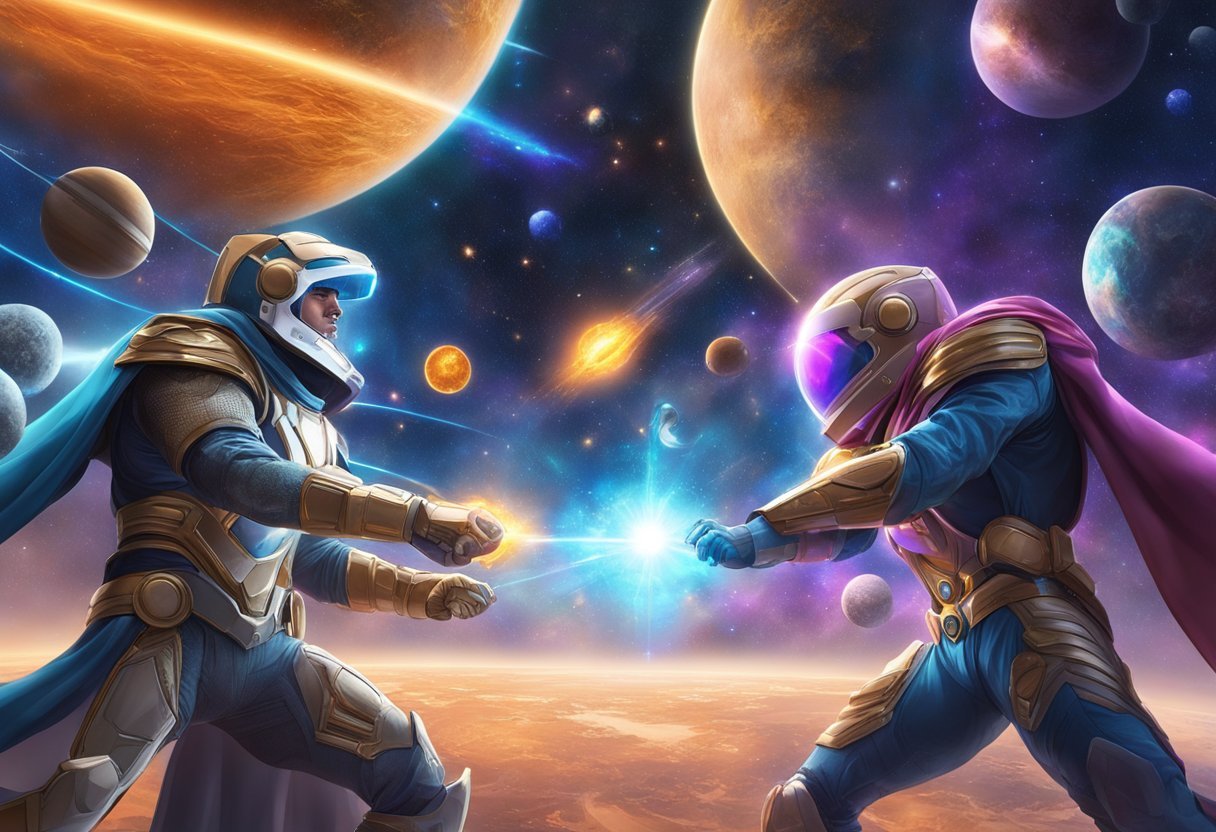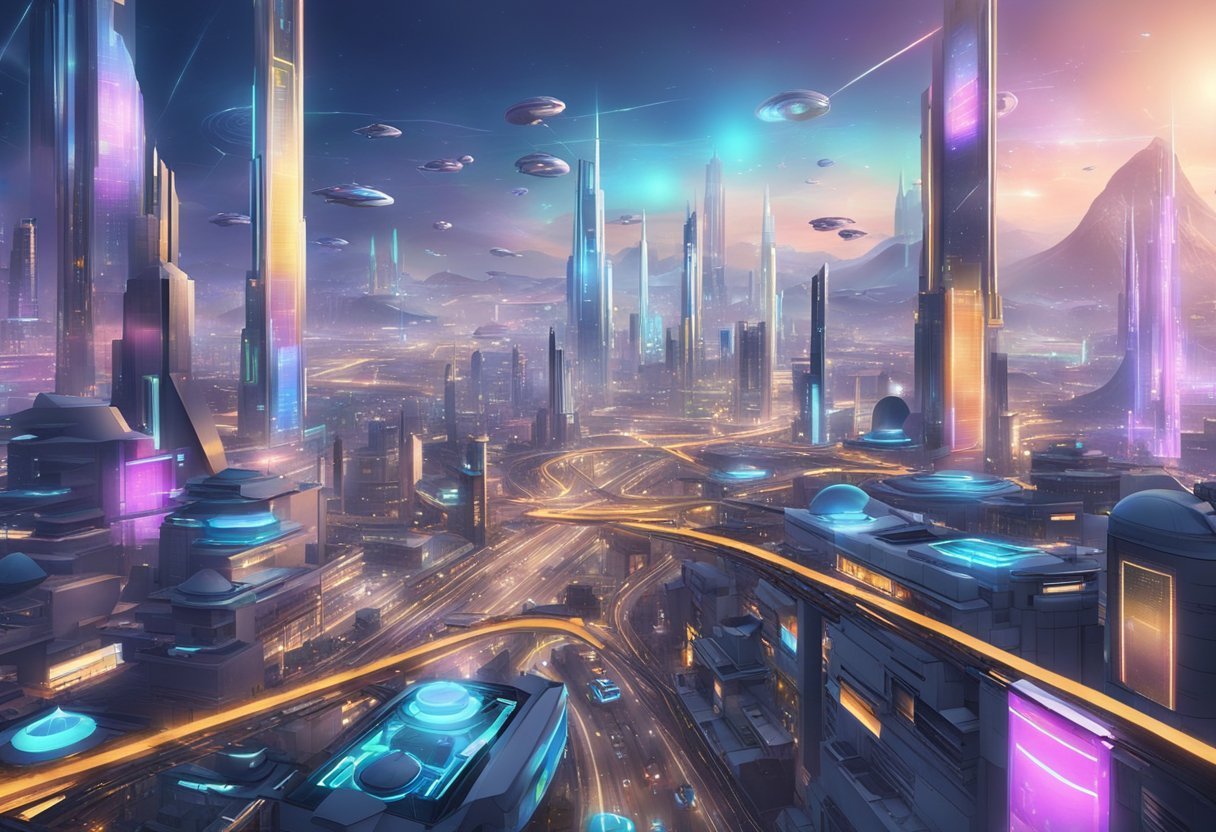The terms “metaverse” and “multiverse” have been gaining popularity in the world of virtual and augmented reality. Both terms are used to describe immersive digital environments where users can interact with each other and with virtual objects. However, there are some key differences between the two concepts that are important to understand.
The metaverse is often described as a single, shared virtual space where users can interact with each other and with virtual objects in real-time. It is typically accessed through virtual reality (VR) devices and is designed to be a fully immersive experience. In contrast, the multiverse is a collection of separate virtual worlds that are connected through a common set of protocols and standards. Each world may have its own rules, physics, and user-generated content, but they can all communicate with each other.
Defining the Concepts
What Is the Metaverse?
The term “metaverse” was coined by Neal Stephenson in his science fiction novel “Snow Crash.” It refers to a collective virtual shared space that is created by the convergence of multiple virtual worlds, augmented reality, and the internet.
The metaverse is a fully immersive experience that allows users to interact with each other and the virtual environment in real-time. It is a three-dimensional space that is persistent, meaning that it continues to exist even when the user logs out.
The metaverse is not limited to gaming or entertainment but has the potential to revolutionize the way we work, learn, and communicate. It is a new form of the internet that is more immersive, interactive, and engaging than the current web.
Understanding the Multiverse
The multiverse, on the other hand, is a concept that has been around in science fiction for decades. It refers to the existence of multiple parallel universes that coexist alongside our own. In the context of virtual worlds, the multiverse refers to the existence of multiple independent virtual worlds that share little or no data.
Unlike the metaverse, the multiverse is not a fully immersive experience. It is a collection of separate virtual worlds that are not connected in any meaningful way. Users must create separate accounts and profiles for each world they wish to visit, and there is no continuity of data between them.
While the multiverse lacks the immersive experience of the metaverse, it does offer more freedom and flexibility for users. They can choose which world they want to visit and how they want to interact with it, without being limited by the rules and restrictions of a single shared space.
While the metaverse and multiverse share some similarities, they are fundamentally different concepts that offer users different experiences. The metaverse is a fully immersive, persistent virtual shared space that is created by the convergence of multiple virtual worlds, augmented reality, and the internet. The multiverse, on the other hand, is a collection of separate virtual worlds that are not connected in any meaningful way.
Metaverse vs Multiverse: Main Differences and Similarities

When it comes to Metaverse and Multiverse, there are both similarities and differences that are important to understand. In this section, we will explore three main differences and three main similarities between Metaverse and Multiverse.
Differences
- Interoperability: On the most fundamental level, the difference between Metaverse and Multiverse is interoperability. Metaverse is a virtual world that is designed to be seamless and interconnected, allowing users to move freely between different virtual spaces. Multiverse, on the other hand, is a collection of separate virtual worlds that are not necessarily designed to work together.
- Ownership: Another key difference between Metaverse and Multiverse is ownership. In Metaverse, users have more control over their virtual assets and properties, and can even own virtual land and buildings. In Multiverse, ownership is often more limited, and users may not have as much control over their virtual assets.
- Functionality: Finally, there is a difference in functionality between Metaverse and Multiverse. Metaverse is designed to be a fully immersive virtual world, with a wide range of activities and experiences for users to enjoy. Multiverse, on the other hand, is often more focused on specific activities or experiences, such as gaming or socializing.
Similarities
- Virtual Worlds: Both Metaverse and Multiverse are virtual worlds, where users can interact with each other and with virtual objects and environments.
- User-generated Content: In both Metaverse and Multiverse, users can create and share their own content, such as virtual objects, buildings, and environments.
- Blockchain Technology: Both Metaverse and Multiverse use blockchain technology to enable secure and transparent transactions within their virtual economies.
While there are some key differences between Metaverse and Multiverse, they share many similarities as well. Whether you prefer a fully immersive virtual world or a more focused and specialized experience, both Metaverse and Multiverse offer unique and exciting opportunities for users to explore and interact in virtual environments.
Technological Foundations
The metaverse and multiverse are both built upon technological foundations that enable immersive and interactive experiences. In this section, we will explore the key technologies that underpin both concepts.
Virtual Reality and Augmented Reality
Virtual reality (VR) and augmented reality (AR) are two of the most important technologies that enable immersive experiences in both the metaverse and multiverse. VR allows users to enter a completely digital environment, while AR overlays digital information onto the real world. Both technologies allow for a highly interactive and visually engaging experience, which is essential for creating immersive digital ecosystems.
The Role of AI and Blockchain
Artificial intelligence (AI) and blockchain are two other important technologies that underpin both the metaverse and multiverse. AI is used to create intelligent virtual agents that can interact with users in a natural and intuitive way. Blockchain, on the other hand, is used to create secure and decentralized digital ecosystems that enable the exchange of digital assets such as cryptocurrencies.
In the metaverse, blockchain is used to create a secure and decentralized economy that enables users to buy and sell digital assets such as virtual real estate, digital art, and even virtual experiences. AI is used to create intelligent virtual agents that can interact with users in a natural and intuitive way, creating a more immersive and engaging experience.
In the multiverse, AI is used to create intelligent virtual agents that can interact with users in a natural and intuitive way, creating a more immersive and engaging experience. Blockchain is used to create secure and decentralized digital ecosystems that enable the exchange of digital assets such as cryptocurrencies, enabling users to buy and sell digital assets such as virtual real estate, digital art, and even virtual experiences.
The technological foundations of both the metaverse and multiverse are complex and multifaceted, requiring a range of cutting-edge technologies to create immersive and engaging digital ecosystems.
Industry Perspectives
Gaming and Entertainment
The gaming and entertainment industry has been at the forefront of the metaverse and multiverse discussions for quite some time now. Companies like Epic, Roblox, and Unity are investing heavily in creating immersive experiences for their users. The metaverse and multiverse are seen as a natural progression for the gaming industry, which has been creating virtual worlds for decades.
In addition to gaming, the entertainment industry is also exploring the potential of the metaverse and multiverse. Virtual concerts and events have become increasingly popular, with companies like Meta (formerly Facebook) investing in creating virtual venues for such events.
Social Media and Communication Platforms
Social media and communication platforms have also been quick to jump on the metaverse and multiverse bandwagon.
Companies like Meta and Microsoft are investing heavily in creating virtual social spaces where users can interact with each other in a more immersive way. The metaverse and multiverse are seen as a natural extension of the current social media landscape, where users are already spending a significant amount of time online.
Business and E-commerce
The potential for the metaverse and multiverse to revolutionize the business and e-commerce landscape is immense. The metaverse and multiverse could offer businesses a new way to interact with their customers, creating immersive shopping experiences that are not possible in the physical world. Companies like Meta and Microsoft are already exploring the potential of the metaverse and multiverse in the e-commerce space.
In addition to e-commerce, the metaverse and multiverse could also offer businesses new ways to collaborate and communicate with each other. Virtual meetings and conferences could become more common, and the metaverse and multiverse could offer businesses a new way to network and connect with each other.
The metaverse and multiverse are seen as the next step in the evolution of the internet. While there are still many challenges to overcome, the potential benefits are immense. As companies continue to invest in the metaverse and multiverse, we can expect to see new and innovative use cases emerge in the coming years.
User Experience and Interaction
Avatars and Digital Identity
One of the key aspects of the metaverse and multiverse is the ability to create and customize avatars, which represent the digital identity of the user. Avatars are persistent across virtual spaces, allowing users to maintain their digital identity and continue to interact with others in different immersive experiences.
Avatars can be customized in a variety of ways, including physical appearance, clothing, and accessories. This customization allows users to express themselves and create a unique digital identity that represents them in the virtual world.
Interactivity and Immersion
The user experience in the metaverse and multiverse is heavily dependent on interactivity and immersion. These virtual spaces aim to provide users with an experience that is as close to real life as possible, allowing them to interact with others and their environment in a meaningful way.
Users can interact with objects and other avatars in the virtual space, and the level of immersion can be increased through the use of virtual reality technology. This creates a sense of presence, making users feel as though they are truly present in the digital world.
The user experience in the metaverse and multiverse is centered around the ability to create and maintain a digital identity through the use of avatars, and the level of interactivity and immersion that is provided in the virtual space.
Comparative Analysis
The Metaverse and Multiverse are two emerging technologies that could change the way we interact with the digital and physical worlds. While both are described as parallel worlds, they have some significant differences.
The Metaverse is a virtual world where users can interact with each other and the environment in real-time. It is a shared space that is entirely digital, where people can create their avatars, buy virtual properties, and participate in various activities. In contrast, the Multiverse is a collection of interconnected virtual worlds that allow users to move between them with ease. It is a decentralized platform that enables users to create their virtual worlds and experiences.
One of the significant differences between the two is the level of centralization. The Metaverse is often controlled by a single entity, while the Multiverse is decentralized. This means that users have more control over their experiences in the Multiverse, while the Metaverse is more limited in terms of customization.
Despite their differences, both the Metaverse and Multiverse share some similarities. For example, both are digital spaces that allow users to interact with each other and the environment. They also have the potential to impact society and culture significantly.
Impact on Society and Culture
The Metaverse and Multiverse have the potential to change the way we interact with each other and the world around us. They could revolutionize the way we work, socialize, and consume media.
One of the significant impacts of the Metaverse and Multiverse is on culture. These digital spaces provide new opportunities for artists, musicians, and other creatives to showcase their work and reach a broader audience. They also allow people to experience new cultures and perspectives that they may not have access to in the physical world.
The Metaverse and Multiverse also have the potential to impact society. They could provide new opportunities for education, healthcare, and social interaction. They could also change the way we think about ownership and property rights, as virtual properties become more valuable and sought after.
The Metaverse and Multiverse are two emerging technologies that have the potential to change the way we interact with the digital and physical worlds. While they have some significant differences, they share some similarities and could have a significant impact on society and culture.
Frequently Asked Questions
How does the concept of a metaverse differ from that of a multiverse?
A metaverse is a virtual world that is created by connecting multiple virtual environments, allowing users to move seamlessly between them. On the other hand, a multiverse is a collection of multiple universes that exist independently of each other. While both concepts involve multiple environments, the key difference is that a metaverse is interconnected, whereas a multiverse is not.
Can a metaverse contain multiple multiverses, and if so, how many?
Yes, a metaverse can contain multiple multiverses. However, the number of multiverses that can be contained within a metaverse is not limited. It depends on the infrastructure and design of the metaverse.
In terms of scale, how does a metaverse compare to a universe?
A universe is a vast expanse of space that contains galaxies, stars, planets, and other celestial bodies. In contrast, a metaverse is a virtual world that is created by connecting multiple virtual environments. While a universe is physical and tangible, a metaverse is digital and intangible. Therefore, it is difficult to compare the scale of a metaverse to that of a universe.
What distinguishes a multiverse from an omniverse?
A multiverse is a collection of multiple universes that exist independently of each other. In contrast, an omniverse is a hypothetical concept that encompasses all possible universes, including those that are purely fictional. The key difference between a multiverse and an omniverse is that the former is limited to existing universes, while the latter includes all possible universes.
How does the complexity of a hyperverse compare to that of an omniverse?
A hyperverse is a concept that describes a universe that contains multiple parallel universes. In contrast, an omniverse encompasses all possible universes, including those that are purely fictional. While both concepts involve multiple universes, the key difference is that a hyperverse is limited to parallel universes, whereas an omniverse includes all possible universes.
What is considered to be beyond the scope of an outerverse?
An outerverse is a hypothetical concept that encompasses all possible multiverses. Therefore, anything that exists outside of the multiverse is considered to be beyond the scope of an outerverse. This includes any hypothetical concepts or realities that are not part of the multiverse.




